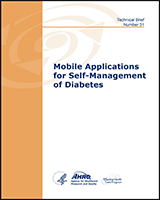Mobile Applications for Self-Management of Diabetes
Technical Brief, No. 31
Authors
Investigators: Stephanie Veazie, M.P.H., Kara Winchell, M.A., Jennifer Gilbert, M.D., M.P.H., Robin Paynter, M.L.I.S., Ilya Ivlev, M.D., Ph.D., Karen Eden, Ph.D., Kerri Nussbaum, M.S., Nicole Weiskopf, Ph.D., Jeanne-Marie Guise, M.D., M.P.H., and Mark Helfand, M.D., M.P.H.Affiliations
Structured Abstract
Background:
While hundreds of mobile applications (apps) for diabetes self-management are commercially available, patients lack information on which apps are effective in improving diabetes-related outcomes.
Purpose:
Examine the evidence, usability, and features of commercially available mobile apps for self-management of type 1 and type 2 diabetes.
Methods:
We searched Ovid/Medline and the Cochrane Database of Systematic Reviews for systematic reviews and technology assessments, and selected five recent, high-quality systematic reviews of highest relevance. We also conducted searches online and through Ovid/Medline, CINAHL, Embase, and ClinicalTrials.gov to identify additional, recently published primary studies. We used predetermined criteria to identify eligible studies, then extracted study-level data. We conducted quality assessments, extracted technical specifications and costs, and evaluated the usability of each app.
Findings:
We identified 15 studies/analyses evaluating 11 unique apps: six apps for type 1 diabetes and five for type 2 diabetes. Two apps had multiple tiers of access (free and paid), which resulted in the evaluation of features of 13 apps. Common features of apps include the ability to track blood glucose, HbA1c, medications, physical activity, and weight. Studies were 2–12 months long. For type 1 diabetes, patients had clinically significant improvement in HbA1c if they used either of two apps and statistically significant improvement using one additional app. For type 2 diabetes, patients using any of three apps experienced clinical and statistical improvement in HbA1c. Patients using two apps for type 1 diabetes experienced improvements in hypoglycemic episodes. Patients did not experience improvements in quality of life, blood pressure, weight, or body mass index outcomes, regardless of the app or type of diabetes. The quality of studies was variable. Study design and presentation made it difficult to distinguish the effect of the app and the effect of additional interactions with study personnel or health care providers. Of the eight apps available for usability testing, three apps (two for type 1 and one for type 2 diabetes) were scored by researchers as “acceptable,” two apps (type 1 diabetes) as “marginal,” and three apps (one for type 1 and two for type 2 diabetes) as “not acceptable.”
Implications:
Some apps for diabetes self-management may improve outcomes in the short-term, but the effect cannot be distinguished from the concomitant effect of additional support from a health care provider. More rigorous and longer-term evaluations are needed to determine how these apps affect weight, blood pressure, quality of life, and complications of diabetes.
Suggested citation:
Veazie S, Winchell K, Gilbert J, Paynter R, Ivlev I, Eden K, Nussbaum K, Weiskopf N, Guise J-M, Helfand M. Mobile Applications for Self-Management of Diabetes. Technical Brief No. 31. (Prepared by the Scientific Resource Center under Contract Nos. 290-2012-0004-C and 290-2017-00003-C.) AHRQ Publication No. 18-EHC010-EF. Rockville, MD: Agency for Healthcare Research and Quality; May 2018. Posted final reports are located on the Effective Healthcare Program search page. https://doi.org/10.23970/AHRQEPCTB31.
This report is based on research conducted by the Scientific Resource Center under contract to the Agency for Healthcare Research and Quality (AHRQ), Rockville, MD (Contract Nos. 290-2012-0004-C and 290-2017-00003-C). The findings and conclusions in this document are those of the authors, who are responsible for its contents; the findings and conclusions do not necessarily represent the views of AHRQ. Therefore, no statement in this report should be construed as an official position of AHRQ or of the U.S. Department of Health and Human Services.
None of the investigators have any affiliations or financial involvement that conflicts with the material presented in this report.
The information in this report is intended to help health care decisionmakers—patients and clinicians, health system leaders, and policymakers, among others—make well-informed decisions and thereby improve the quality of health care services. This report is not intended to be a substitute for the application of clinical judgment. Anyone who makes decisions concerning the provision of clinical care should consider this report in the same way as any medical reference and in conjunction with all other pertinent information, i.e., in the context of available resources and circumstances presented by individual patients.
This report is made available to the public under the terms of a licensing agreement between the author and the Agency for Healthcare Research and Quality. This report may be used and reprinted without permission except those copyrighted materials that are clearly noted in the report. Further reproduction of those copyrighted materials is prohibited without the express permission of copyright holders.
AHRQ or U.S. Department of Health and Human Services endorsement of any derivative products that may be developed from this report, such as clinical practice guidelines, other quality enhancement tools, or reimbursement or coverage policies may not be stated or implied.
Persons using assistive technology may not be able to fully access information in this report. For assistance contact vog.shh.qrha@cpe.
